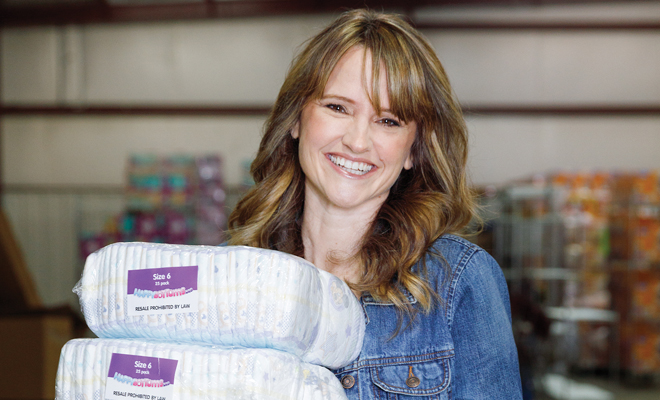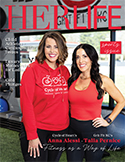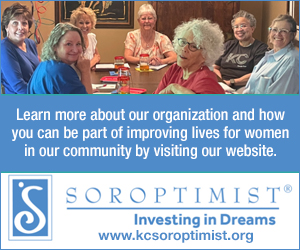 Amber J Deery
Amber J Deery
Jill Gaikowski: Starting at the Bottom for Family Services
When your bundle of joy arrives from the hospital, this newborn depends on you for everything, from feeding to burping to interacting and, especially, to changing diapers. In fact, parents will switch out swaddling bottoms between 2,500 to 3,000 times every year. With that many changings, why in the world would a parent decide she needed to be even more involved with diapers? But that’s just what Prairie Village, Kansas, resident and mother Jill Gaikowski set out to do when she founded HappyBottoms in 2009.
“No, I’m not sick of diapers,” she laughed. “I walk into the warehouse and see the volunteers getting diapers ready for distribution, and it’s an awesome feeling to me. My role with HappyBottoms has evolved over the years, and now, I play the role of the executive director and fill that need. Because I’m helping with fundraising and other roles, I’m not around the diapers as much, and sometimes I do miss that.”
It’s a Necessity of Life
While many moms and dads easily reach for a new “bottom covering” for their little ones, many do not have that luxury. Some may have to consider trading out the cost of their noon-time meal to ensure money is available to purchase more diapers. Some even revert to hanging up used diapers to dry for another application, which can bring negative health and hygiene consequences for the child. Estimates are that thousands of Kansas City-area children need diaper assistance. Diapers can cost up to $125 per child per month, which can be ten percent or more of some low-income families’ budgets. Unfortunately, no government safety net programs help parents defray the cost of covering up their children.
In 2009 Jill was undergoing an intensive soul-searching opportunity. Her daughter, Riley, who’s now 12, was a toddler, while Jill was a stay-at-home mom. She loved being a parent but knew something was missing from her life. A friend suggested she read an article on a diaper bank in California, and the spark was lit for Jill.
“I had just gone to Costco and bought diapers with my daughter; it was easy for me to get them. But the article made me realize this simple process is so hard for many parents. I knew that I needed to do something,” she recalled. “I partnered with several local businesses to do a 7,000 Diapers in 7 Days drive and ended up collecting 15,000 diapers. At that point, I knew the community understood the need and would support HappyBottoms. Becoming a 501(c)(3) was the next step to truly help the families in our community. I also developed a list of partner agencies already serving parents in the community. Distribution started in 2010 and things have snowballed ever since.”
Ins and Outs of Business
In August of this year, the organization celebrates ten years of covering the bottoms of KC children. When things kicked into high gear that first full year, 80,000 diapers were distributed from her garage with the help of eight partner agencies, two volunteer staff and three board members. In 2018, more than two million diapers were given to at-need parents through 37 partner agencies. Three thousand children every month owed their dry and clean behinds to their parents and HappyBottoms.
“We are able to purchase discounted diapers through a partnership with the National Diaper Bank Network, and we order exactly what we need,” explained Jill. “We work with local businesses and volunteers, and they’ve helped us set up our warehouse in Waldo and continually evaluate our processes and systems. We’re fortunate to have their support. The warehouse is operated with just-in-time inventory, first in and first out.”
Family Health Support
What drives this diapering dilemma for parents is that the cost isn’t covered by government programs. As Jill reports, you can buy Cheetos® with assistance, but not diapers. She estimates 20,000 children in Kansas City need diaper aid, and HappyBottoms reaches only half of them. This problem affects not only the child but the entire family.
“Moms are twice as likely to suffer from depression when they don’t have diapers, and maternal depression affects the overall health of the family,” remarked Jill. “We’ve found that 23 percent of low-income families used payday loan companies to buy diapers, and 57 percent reported they missed work or school because they couldn’t supply diapers to daycare providers. A study in 2012 found that families are short 10 to 12 diapers a week, and sometimes they’re forced to decide whether to buy dinner tonight or diaper the baby.”
Gateway to Change
To cover that gap, HappyBottoms provides a monthly supply of 50 diapers or 30 training pants to low-income children through 49 social service agency locations. These partners provide other support to at-risk families with healthcare, emergency assistance, education, childcare and case management services. What enhances the work of HappyBottoms is that diapers can be the first step to moving out of poverty.
“Our partner agencies provide other emergency assistance for our families. Sure, diapers won’t solve all their problems, but we know diapers are a gateway to all of these other agencies for their services,” noted Jill. “We’re able to reach them through diapers and then they can receive other services. When you support HappyBottoms, you’re also supporting the opportunity for a family to be introduced to other services they might not have asked for or known were available.”
From Diapers to Independence
As the children grow, so does HappyBottoms. About five years ago, Jill and her team added a new segment called Bundles of Joy. It provides mothers and their newborns a one-time distribution of 75 diapers and education on how the organization can offer support throughout the child’s early years. Jill is especially proud of the new Potty Training Education program, which ultimately eliminates diaper expense and closes out the phase of diaper need. Participants receive a video curriculum and Potty Training Kit, including a potty seat, stepstool, informational booklet, board book and a sticker chart.
“We built the Potty Training program last year because we know families struggle with potty training,” commented Jill. “We created our own potty training curriculum with a video, book to read, stickers and other educational tools. Families say it’s life-changing.”
In 2019, HappyBottoms will serve a monthly average of 3,716 children through its diaper distribution programs and reach over 11,000 unduplicated children for the year. The positive impact has been enormous for not only the children but their mothers as well. “We had a mom who left an abusive relationship with her two small children and lived in a shelter. Getting resources when you’re low income, and especially when you’re homeless, is so very important,” shared Jill. “At the shelter, she learned about HappyBottoms and it gave her a confidence boost. She knew she wanted to build a better life for her kids, and she set herself on a track to get a job and then a lease on an apartment for a new home. HappyBottoms helped make that happen.”
Creating Synergy
While rewarding stories such as this one are frequent, Jill also points to the satisfaction of bringing together people who are driven to help others and those who want to help themselves and their children break free from the clutches of poverty. “There are so many kind and amazing human beings out there,” stated Jill. “I’ve met so many moms working so hard to make a better life for their families. Their battles are impressive, but they’re really just like me—moms who simply want the best for their kids. HappyBottoms has taught me we have to remember that anyone could be in this position because life situations change.”
With nearly ten years of nonprofit experience under her belt, Jill shares that her success with HappyBottoms would not have been possible without the work of hundreds of volunteers, a committed board of directors and hardworking staff members.
“The phrase ‘It takes a village’ is totally applicable to starting a nonprofit, and you have to keep adding to that village. You don’t have to know everything,” she advised. “I’ve worked with amazing, smart women throughout the history of HappyBottoms, a staff that understands every role is important, an angel network of volunteers and a supportive board. No matter what you’re doing in life, find your village.” ■
To learn more about HappyBottoms and to donate to the program, visit happybottoms.org.









